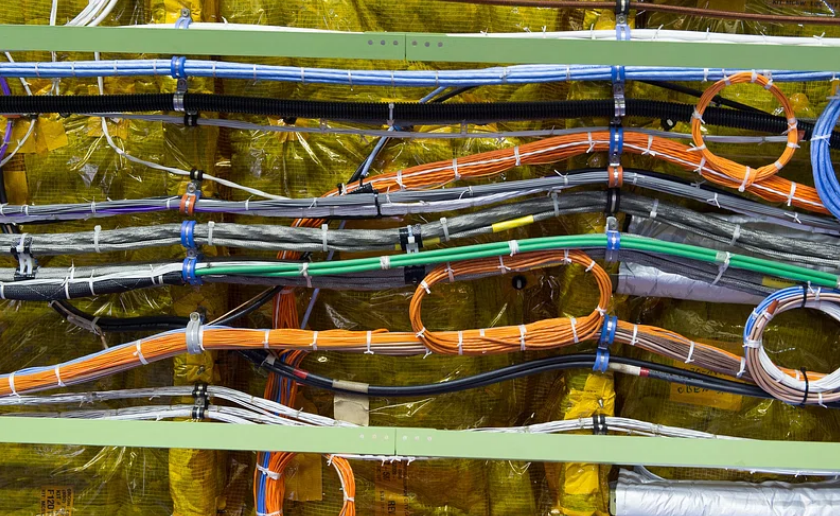Cable trays are an integral part of modern industrial infrastructure and civil architecture. With the rapid development of electrification and informatization, their importance cannot be overstated. However, ensuring their safety and reliability is paramount since cable tray support and maintenance is often challenging and can result in substantial economic and societal losses in the event of accidents.
Recent decades have seen significant developments in the field of cable trays. Researchers have examined various aspects of cable tray design and performance, taking into account service requirements such as:
- Seismic resistance,
- Corrosion resistance,
- Flame-retardant capabilities, and
- Resistance to electromagnetic interference.
This is particularly true for cable-stayed bridges or rooftop designs with a large number of cables. These studies have led to the development of safer and more efficient cable tray systems.
In addition to traditional requirements, new demands have emerged, including the need for cable trays with larger spans, lighter weights, and easier construction, reflecting the drive toward resource conservation and eco-friendliness.
In this article, we will take a closer look at how cable tray support solutions help improve rooftop and property safety, hence leading to better compliance and reliability. We'll also introduce some key considerations professionals need to make for these rooftop support systems.
Key Elements in Cable Tray Support Selection
When installing a cable tray support solution, there are three major elements to consider:
- Seismic & Corrosion Resistance: To ensure long-term safety and reliability, cable trays must have the capacity to withstand seismic forces and resist corrosion. Any failure can lead to substantial economic and societal losses.
- Large Span, Lightweight, & Ease of Construction: As new demands emerge for cable trays, including large spans, lightweight materials, and ease of construction, engineers must adapt designs to meet these requirements while maintaining safety and reliability.
- Stress & Deformation: The ability to resist both stress and deformation is crucial in cable tray design. Whether used for power transmission or control equipment, cable trays must maintain their structural integrity while being able to handle deformations.
All these elements can primarily be attributed to the strength-stiffness ratio. This ratio quantitatively defines the relationship between the static load strength compared to stiffness of a cable tray.
Strength-Stiffness Ratio of A Cable Tray
The strength of a cable tray refers to its capacity to bear loads without sustaining damage, while stiffness refers to its ability to resist deformation. Both strength and stiffness are vital aspects of a cable tray's performance. By analyzing this ratio, we can optimize cable tray design, leading to more economical and sustainable solutions.
To ensure the optimal performance of cable trays while maintaining safety, achieving an ideal strength-stiffness ratio is key. This ratio, expressed as a value close to 1, ensures that both strength and stiffness conditions are met simultaneously, maximizing material utilization and economic benefits. Achieving the right balance between strength and stiffness is crucial, and the strength-stiffness ratio helps in optimizing this balance.

Figure: Sample relationship graph between strength and stiffness.
The graph above illustrates the relationship between the strength-stiffness ratio of the cable tray and its load characteristic curves. It shows how this ratio affects performance under different span conditions.
When the strength-stiffness ratio is higher than 1 (in the part where the dimensionless span is less than 1), there is a significant difference between the load characteristic curves. Here, it is recommended to conduct tests using load control combined with deflection measurement. This signifies that the cable tray is more rigid, and load control is the preferred testing method.
When the ratio is lower than 1 (in the part where the dimensionless span is higher than 1), the load characteristic curve based on strength is located above the curve based on stiffness. In such cases, it is better to perform load tests with deflection control, as the cable tray's stiffness is not as dominant, and this approach ensures a relatively safer working load.
In the range where the dimensionless span is both greater than 1 and less than 1, there is minimal difference between the two curves. This is considered acceptable in engineering terms and indicates that a strength-stiffness ratio close to 1 is reasonable. However, significant differences between the designed spans and the actual installation site conditions may warrant a redesign of the cable tray support system to ensure safety and performance.
PHP Systems/Design leverages the concept of the strength-stiffness ratio to engineer cable tray solutions that prioritize durability and long-lasting performance. We carefully balance the strength and stiffness of our cable tray designs. This allows our solutions to withstand the demands of real-world applications.
This approach allows us to offer cable tray solutions that provide both structural integrity and flexibility, which is crucial for accommodating varying span distances and load conditions. We ensure that our strength-stiffness ratio is close to 1. This, in turn, means that our cable trays are well-suited to handle a range of spans and loading scenarios. Furthermore, it allows for better OSHA compliance as well.
Application of Strength-Stiffness Ratio
The strength-stiffness ratio has practical implications during both the design phase and the testing phase of cable trays.
In the design phase:
- If the strength-stiffness ratio is higher than 1, it indicates that the stiffness is relatively higher than the strength. In such cases, cable trays can be designed to meet the strength condition and will automatically satisfy the stiffness condition. This leads to efficient material utilization, as the cable tray is operating in an ideal working condition.
- If the strength-stiffness ratio is lower than 1, it implies that the strength requirement takes precedence over stiffness. Here, the cable tray must meet the stiffness condition for it to also meet the strength condition. In these cases, the cable tray may be designed to ensure that the strength is maximized, making full use of the material's strength potential.
In the testing phase:
The strength-stiffness ratio also plays a crucial role in testing cable trays. If the ratio is greater than 1, tests can be conducted with a focus on load control and deflection measurement. If the ratio is less than 1, the tests are better suited for deflection control, possibly involving stepwise loading and unloading. These tests help determine the safe working load for cable trays under various conditions.
Determinations of Strength-Stiffness Ratio
The strength-stiffness ratio can be determined using numerical analysis, finite element methods, or experimental testing. By comparing the values of maximum dimensionless deflection and maximum stress, obtained either from numerical simulations or physical tests, the strength-stiffness ratio can be assessed. The results from these analyses or tests can then be used as references for optimizing cable tray designs.
Different Materials & The Strength-Stiffness Ratio
The material from which a cable tray is constructed significantly impacts the strength-stiffness ratio. Different materials have varying allowable strain and conditional yield strain values. For instance, cable trays made from engineering plastics typically have lower strength but higher conditional yield strain values than metal-based trays.
Thus, the material used should be carefully considered when designing and evaluating cable trays, as it can affect the cable tray's strength-stiffness ratio and, consequently, its performance. PHP uses a blend of galvanized steel, stainless steel, and aluminum for its cable trays. The idea is to reduce the risk of corrosion and at the same time ensuring that the trays are durable.
Load Tests & Strength-Stiffness Ratio on
The strength-stiffness ratio's influence extends to load tests for cable trays. These tests are often conducted across a range of spans to establish load-span curves, or load characteristic curves. The results from these tests help manufacturers understand the performance of their products under different conditions.
The strength-stiffness ratio affects the load tests, especially in cases where cable trays have different spans. In the part where the dimensionless span is less than 1, and the strength-stiffness ratio is greater than 1, load control is used to assess the cable tray's performance. In contrast, if the dimensionless span is greater than 1 and the strength-stiffness ratio is less than 1, deflection control is more appropriate.
How PHP Systems/Design Can Assist
At PHP Systems/Design, we specialize in crafting customized cable tray support solutions that take the strength-stiffness ratio and several other critical elements into account. These include, but aren't limited to:
- Allowable strain,
- Allowable dimensionless deflection,
- Height-span ratio, and
- Characteristic coefficient.
Our objective is to ensure that your cable tray system operates in an ideal condition, where safety is never compromised, and material usage is optimized. Whether your project requires cable trays for power transmission or control equipment, our expert team can provide a solution tailored to your unique needs.
Request Test Data for Your Property
To get a better understanding of how different materials and designs can benefit your property, PHP Systems/Design invites you to request test data from our professionals. By doing so, you'll be able to make informed decisions about your cable tray support system based on real-world data. If you're ready to get started, you can also request pricing and get started on your project right away!



